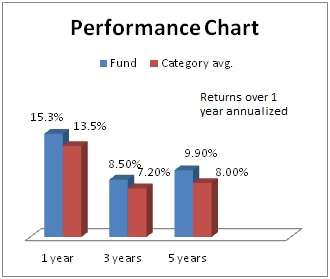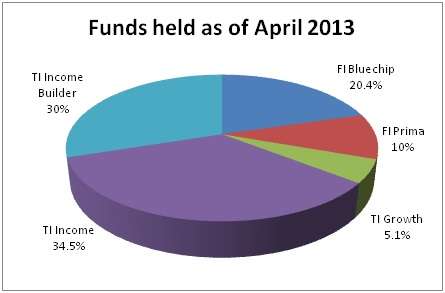For a slice of equity
Investors looking for some kicker returns from equities without too much exposure to the asset class can consider investments in FT India Life Stage Fund-of-Fund – The 40s Plan (FT India 40s Plan).
FT India 40s Plan delivered 11.3% since its launch in late 2003. Its return in the last 3 and 5 years bettered its category average as well as its benchmark – a blend of Sensex, CNX 500 and Crisil Composite Bond index.
Suitability
FT India 40s plan is a debt-oriented fund-of-fund which invests in a mix of equity and debt funds from the Franklin India stable. It has about 35% exposure to equity funds and rest in debt funds. That means it has higher exposure to equities than most debt-oriented MIPs (which have about 20-25% in equities). To this extent, the fund tends to take a bigger hit than MIPs in down markets. Conversely, in rallying markets, it performs better.
The fund is suitable for investors who have tested waters in mutual funds and wish to slowly up exposure to equities. We would prefer beginners to hold MIPs over this fund.
Although named the 40s Plan, the fund is suitable for investors with any age profile as long as they wish to keep exposure to equities to about a third. An investor looking for higher equity exposure than this would be better off with a balanced equity-oriented fund.
Being a debt-oriented fund, FT India 40s Plan will be subject to long capital gains tax for holding over a year as well (short-term capital gains if held less than a year). Investors can consider phased exposure in the fund through the SIP route, given that its equity component will provides opportunities to average cost.
Performance
With a return of 15.3% in the last 1 year, FT India 40s Plan delivered better than MIPs. Yet it was a notch lower than its blended benchmark index return of 16.1%. Clearly, the fund could not keep up with the equity rally, given its restricted holding and that too predominantly in large-cap funds.

That said, the fund has a consistent track record of beating its benchmark. On a rolling one-year return basis, for data taken in the last 3 years, the fund bet its blended benchmark 95% of the times.
FT India 40s Plan also did better than funds in the debt-oriented category, especially in rallies. This was evident in years such as 2005, 2007, 2009 and 2010. But in bear markets such as 2008, FT 40s Plan fell as much as 19% even as category peers such as HDFC MIP LTP contained fall to less than 9%.
Clearly, the additional equity exposure can cause some damage in a market rout. It is for this reason that during longer periods of volatility (as is the case in the last 3 and 5 years), FT 40s Plan would score only next to HDFC MIP LTP or Reliance MIP on a risk-adjusted return basis.
Portfolio
In its equity pie, FT India 40s Plan held about 20% in Franklin India Bluechip, a large-cap fund with a consistent long-term record. It held close to 10% in Franklin India Prima for some mid-cap exposure and about 5% in Templeton India Growth. The last-mentioned fund follows a value-oriented approach.

In its debt holding, Templeton India Income fund saw a 35% exposure while Templeton India Income Builder Account received about 30%. The former is a medium-term debt fund with portfolio maturity of a little over 4 years. It did not hold any gilts as of April.
The latter is a more aggressive fund with close to 50% in gilts and with a longer portfolio maturity. This combination works well to tap opportunities across the yield curve. The 1-year return of these 2 funds stood at 12% and 15% respectively.
The fund is managed by Anand Radhakrishnan, Sachin Padwal-Desai and Pallab Roy.








Dear vidya,
What is your take on MNC funds? I run an SIP in BSL MNC fund for the past 18 months. So far my annualised return is around 13-14 %.
Rgds
Ajith
Hello Ajith,
MNC funds have had a long rally, given that the risk averse market has preferred cash-rich MNC stocks in the last few years. But then their valuations (mostly from pharma, FMCG) have also sky-rocketed. Hence, while they may continue to return well, do not expect the kind of rally seen in the last 3-4 years. Also, given that it is a theme fund, it is best to restrict exposure to 10-15% of your portfolio. Any excess can be booked as profits. Tks, Vidya
Dear Vidya,
A humble request, could you please throw some light on Sector Funds, specially Pharma, FMCG and Infra (I know people shun away from this, but still….).
Your analysis and approach helps many to go forward or atleast understand those Funds, rather than people just seeing past returns and investing.
Thanks in Advance,
Sunil.
Hi Sunil,
Discussing the fortunes of every sector would be beyond the scope of this forum, given the time and expertise required. You may wish to read an earlier article on sector funds: https://blog.fundsindia.com/blog/mutual-funds/should-you-have-sector-funds-in-your-portfolio/2301
thanks, Vidya
Dear Vidya,
A humble request, could you please throw some light on Sector Funds, specially Pharma, FMCG and Infra (I know people shun away from this, but still….).
Your analysis and approach helps many to go forward or atleast understand those Funds, rather than people just seeing past returns and investing.
Thanks in Advance,
Sunil.
Hi Sunil,
Discussing the fortunes of every sector would be beyond the scope of this forum, given the time and expertise required. You may wish to read an earlier article on sector funds: https://blog.fundsindia.com/blog/mutual-funds/should-you-have-sector-funds-in-your-portfolio/2301
thanks, Vidya
Dear vidya,
What is your take on MNC funds? I run an SIP in BSL MNC fund for the past 18 months. So far my annualised return is around 13-14 %.
Rgds
Ajith
Hello Ajith,
MNC funds have had a long rally, given that the risk averse market has preferred cash-rich MNC stocks in the last few years. But then their valuations (mostly from pharma, FMCG) have also sky-rocketed. Hence, while they may continue to return well, do not expect the kind of rally seen in the last 3-4 years. Also, given that it is a theme fund, it is best to restrict exposure to 10-15% of your portfolio. Any excess can be booked as profits. Tks, Vidya